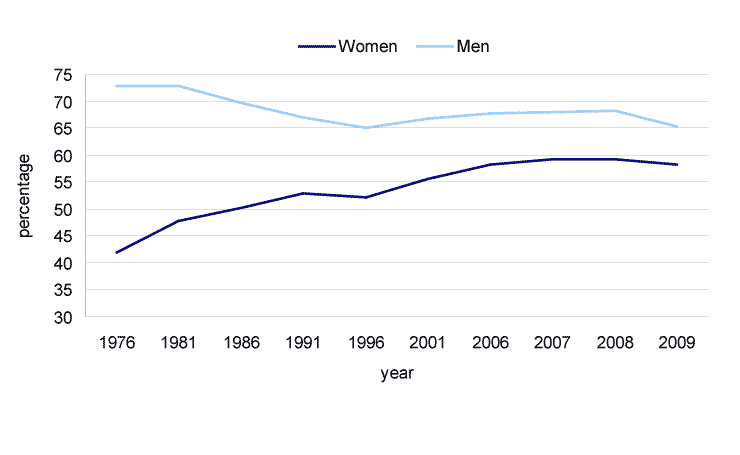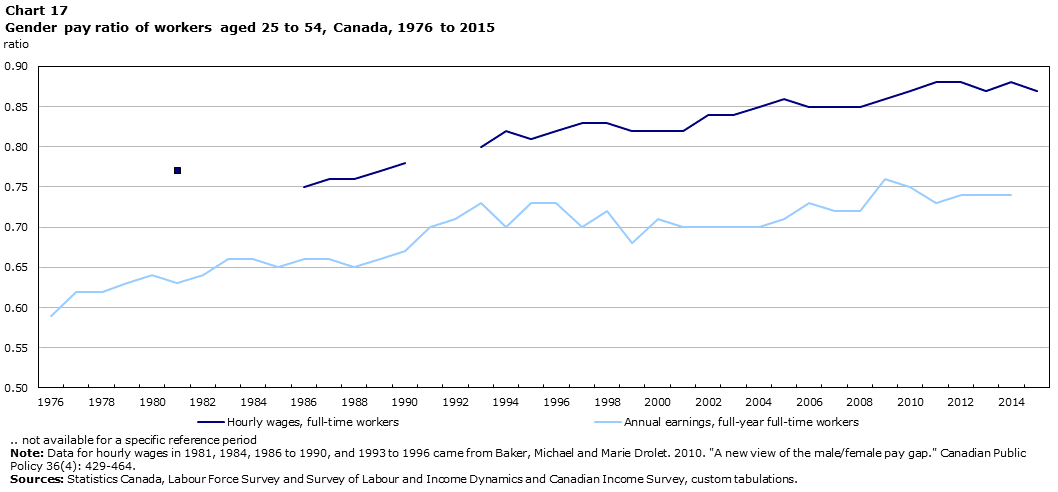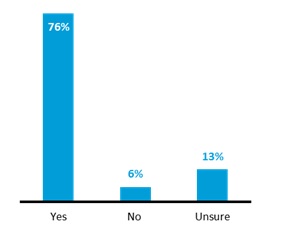Gender Discrimination In Workplace
Definition
Gender discrimination is differences between men and women based on political · economic · cultural · social awareness. Such discrimination takes place many aspects, including workplace. Because of gender discrimination, some do not have the equal opportunities as others for many aspects such as education and careers.
General Concepts
Social sex discrimination exists in various forms. A typical example of discrimination is in the workplace. Gender discrimination appears when women starts to walk on the road to career. According to polls from Statistics Canada [1], although the rates of women employment in 2009 has been doubled as 58.3% - representing around 8.1 million women - from 1976, still many women - rest 40% - still experience discrimination in employment.
 Figure 1. Employment rates of women and men, 1976 to 2009
Figure 1. Employment rates of women and men, 1976 to 2009
Using the Labour Force Survey, the percentage of women who are employed has generally followed an upward trend over the past three decades, but has declined during economic downturns. Discrimination is still present after they starts own career, almost half of women (45%) think they have personally experienced discrimination in the workplace because of their gender and 8 in 10 of women (83%) in full time employment believe gender discrimination is still present in the workplace [2].
Types of Gender Discrimination
Women
Canadian women are not equally represented in the most lucrative and powerful paid employment, and they continue to be streamed into ‘women’s work’.
- In 2004, 67% of women doing paid work were teaching, nursing or doing clerical or administrative work, compared to only 30% of men. this number has remained virtually unchanged for over a decade.
- Women continue to occupy only 37% of managerial positions. However, only 22% of senior management positions are held by women, a decrease from 27% since 1996.
- In 2004 women made up only 21% of professionals in the natural sciences, engineering, and mathematics, a number that has not changed significantly since 1987. [7]
Women in Canada are more likely than men to be in part-time, temporary, or multiple jobs, which are less likely to have pensions and other benefits. This is not necessarily by choice, but because of childcare responsibilities or because they are unable to find full-time work.
- Approximately 40% of women, compared with less than 30% of men, are in part-time, contract, or other non-standard work arrangements.
- In 2007, 21.2% of Canadian women worked part-time, compared to 6.4% of men.
- In 2004, 26% of women part-time workers indicated that they wanted full time employment, but could only find part-time work.
Men
Occupational segregation - ideas about what jobs as gender should do - is the main discrimination that men are likely to be experience regarding their gender. [3]
- In 2014, Ventura Corporation, a Puerto Rico-based wholesaler of makeup, beauty products, jewelry and other personal care items to retail sellers, has agreed to settle a sex discrimination lawsuit filed by the U.S. Equal Employment Opportunity Commission (EEOC). The EEOC charged in its suit that Ventura engaged in a pattern or practice of refusing to hire men as Zone Managers and Support Managers. [5]
- According to the EEOC, sexual harassment cases filed by men made up 16.4 percent of the 11,717 sexual harassment charges in fiscal year 2010, compared to about 8 percent in 1990,
Forms of Gender Discrimination
Gender Pay Gap
Canadian women are paid less than their male counterparts across all age groups and education levels. Women earn less than men working in the same sectors, or even in the same jobs. According to Statcan, women earn $0.87 for every dollar earned by men; - the size depends on the measure of earnings that is used the annual earnings of full‑time, full‑year workers - women earned an average of $25.38 per hour in 2014 whereas male earned an average of $28.92/hour.

Figure 2. Gender Pay Ratio of Canadian labour aged 25 to 54, 1976 to 2015
A number of explanations for existence of the gender wage gap within occupations have been suggested as follows:
- Women choose the less demanding and/or more flexible positions in order to accommodate their caregiving responsibilities
- Women may also be less adept at negotiating their pay or less interested in competing,
- Women are more likely to work part time than men
Although Canadian government does not have legit regulation or Act toward gender pay gap, there were few major steps toward equality in the workforce in which passing of the Fair Employment Practices Act and the Female Employees Fair Remuneration Act in Ontario, in 1951. The Fair Employment Practices Act aimed to eliminate discrimination by implementing fines and creating a complaints system. The Female Employees Fair Remuneration Act was designed to provide women with equal pay for work of equal value. The rest of Canada’s provinces and territories quickly followed Ontario’s lead in adopting similar provincial acts to ensure equality in the workforce. It states [6]
- the Canada Fair Employment Practices Act of 1953, which applied to the civil service;
- the Female Employees Equal Pay Act of 1956, which made wage discrimination based on sex against the law; and
- the Employment Equity Act of 1986, which applies to federally regulated employees and requires employers to identify and eliminate unnecessary barriers that limit employment opportunities.
Work Environment
Pregnancy in the workplace is a human rights issue of equality of opportunity: women should not suffer negative consequences in the workplace by pregnancy. The Canadian Human Rights Act prohibits discrimination regards to pregnancy. Although all federally regulated employees with pregnancy are protects by Act from discrimination in the workplace, it is subtle that pregnancy-related discrimination is presented in any forms of action, decision or policy that affects negatively on them.
Women’s representation in both public and private leadership positions is also important. Women’s limited access to informal networks, influential colleagues and mentors related to their organizational roles are entrenched because association of leadership are generally deemed to be the men; this are also known as glass ceiling - unofficially acknowledged barrier to career advancement in profession.
Since the 1960s, through the Public Service Commission of Canada and the Employment Equity Act, the federal government tried to make its workforce representative as Canadians who have historically been disadvantaged, including women. The proportion of women in the top private sector positions was resulted as 25.6% in 2015 - increment by 11.3 percentage more than 1987.
Sexual Harassment
Sexual harassment occurs when an employee is subjected to unwelcome comments or conduct of a sexual nature. According to Government of Canada Statistics, most online survey respondents - 1005 respondents identified as female and 200 respondents identified as male - who reported that they have experienced harassment, sexual harassment or violence in the past two years indicated that they experienced these behaviours more than once. Harassment was the most common type of behaviour experienced by online survey respondents—a full 60 percent reported having experienced; 30 percent of experienced sexual harassment, 21 percent of experienced violence, and 3 percent of experienced sexual violence [8].
| Experienced | Experienced in past two years | |
|---|---|---|
| Harassment | 60% | 42% |
| Sexual Harassment | 30% | 12% |
| Violence | 21% | 14% |
Table 1. Frequency of harassment and violence experienced

Figure 3. Frequency of harassment and violence experienced
Interestingly, about 76% of survey respondents indicated that their workplace has a sexual harassment policy. However, only 43% of this group have participated in training on the policy. Around half of the online survey respondents who answered the question about their workplace sexual harassment policy indicated that it outlines the consequences for engaging in these types of behaviours, while 31% are unsure of the consequences [8].
| Yes | No | Unsure | |
|---|---|---|---|
| Category | 76% | 6% | 13% |
Table 2. Sexual harassment policy training

Figure 4. Sexual harassment policy training
Around 75% of survey respondents who experienced harassment or violence took action—but 41% of reported has made no attempt to resolve the issue. The types of processes used to resolve their most recent incident shows as follows [8]:
- Over 40% indicated that no attempt was made to resolve the issue
- 21% used an informal conflict resolution process provided by the employer
- 16% filed a formal complaint.
- 5% of cases involved using a “competent person” (third-party) to conduct an investigation.
Resolution was difficult for respondents; 75% of experienced obstacles while trying to resolve the issues. Common barriers were:
- the supervisor or manager did not take the complaint seriously
- the supervisor or manager did not initiate an investigation
- the employee experienced retaliation from individuals in positions of authority
Reactions
Knowing how to respond to gender bias discrimination in workplace is essential for employees, including employers as well.
If experienced or witnessed gender bias in the workplace:
- Keep All Documents, Emails, Voice Messages, and Other Communication
- Bring It Up Privately
- Ask For An Explanation
- Tell Upper Management or someone outside of work
There are few ways to reduce gender discrimination in workplace just by employers/companies:
- Educate Employees on how to handle gender bias situations and what is NOT sexual harassment
- Establish Networking Initiatives
- Emphasize Inclusion of the Opposite Sex
"Gender diverse companies have higher returns than non-gender diverse companies. They have lower risk, greater innovation, greater employee engagement. The performance of companies with gender-diverse teams is so much better." by Sallie Krawcheck, of Ellevest lnc - firm primarily aims to provides its services to women clients. [9]
References
[1] Statcan.gc.ca. (2018). Paid Work. [online] Available at: https://www.statcan.gc.ca/pub/89-503-x/2010001/article/11387-eng.htm [Accessed 8 Apr. 2018].
[2] Investorsinpeople.com. (2018). 83% of women think gender discrimination exists in the workplace | Investors in People. [online] Available at: https://www.investorsinpeople.com/press/83-women-think-gender-discrimination-exists-workplace [Accessed 7 Apr. 2018].
[3] Curtis, P. (2018). Sex discrimination at work hits men too. [online] the Guardian. Available at: https://www.theguardian.com/money/2006/feb/25/discriminationatwork.workandcareers1 [Accessed 9 Apr. 2018].
[4] The Balance. (2017). Gender Discrimination: It Happens To Men, Too. [online] Available at: https://www.thebalance.com/gender-discrimination-against-women-and-men-3515719 [Accessed 10 Apr. 2018].
[5] Eeoc.gov. (2014). Ventura Corporation to Pay $354,250 to Settle EEOC Lawsuit for Sex Discrimination Against Men. [online] Available at: https://www.eeoc.gov/eeoc/newsroom/release/4-3-14.cfm [Accessed 6 Apr. 2018].
[6] Heritage, C. (2017). Rights of women - Canada.ca. [online] Canada.ca. Available at: https://www.canada.ca/en/canadian-heritage/services/rights-women.html#a2c [Accessed 9 Apr. 2018].
[7] Tbinternet.ohchr.org. (2008). Women’s Inequality in Canada. [online] Available at: http://tbinternet.ohchr.org/Treaties/CEDAW/Shared%20Documents/CAN/INT_CEDAW_NGO_CAN_42_8234_E.pdf [Accessed 9 Apr. 2018].
[8] Canada, E. (2017). Harassment and sexual violence in the workplace - Canada.ca. [online] Canada.ca. Available at: https://www.canada.ca/en/employment-social-development/services/health-safety/reports/workplace-harassment-sexual-violence.html#h2.2 [Accessed 10 Apr. 2018].
[9] Ellevest. (2018). Ellevest. [online] Available at: https://www.ellevest.com [Accessed 10 Apr. 2018].